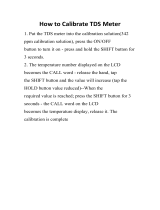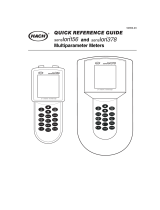
Table of Contents
GENERAL GUIDE .................................................................................. 1
1. Overview For All Meters ........................................................................................ 3
1.1 About the Meters ............................................................................................................................... 3
1.1.1 Display Overview .................................................................................................................... 3
1.1.2 Key Functions ......................................................................................................................... 3
1.2 Inserting Batteries ............................................................................................................................. 4
1.2.1 Inserting batteries for the first time ......................................................................................... 4
1.2.2 Changing batteries subsequently ........................................................................................... 4
1.3 Attaching the Belt .............................................................................................................................. 5
1.4 Connecting Peripherals ..................................................................................................................... 6
1.4.1 Probes (pH/Conductivity/DO) ................................................................................................. 6
1.4.2 Protective Rubber Boot .......................................................................................................... 7
2. System Setup Mode For All Meters ...................................................................... 8
2.1 About Setup Mode ............................................................................................................................ 8
2.2 Accessing Setup mode ..................................................................................................................... 8
2.3 Setup Selection: System Settings ..................................................................................................... 9
2.4 Accessing Setup mode when password protection enabled .......................................................... 15
2.5 Modifying Setup parameters ........................................................................................................... 16
3. Calibration Mode For All Meters ......................................................................... 17
3.1 About Calibration ............................................................................................................................. 17
3.2 About Conductivity/ Resistivity/ TDS/ Salinity Calibration ............................................................... 17
3.3 Preparing the Meter for Calibration ................................................................................................. 17
3.4 Accessing Calibration mode............................................................................................................ 19
3.4.1 Accessing Calibration mode when password protection enabled ........................................ 19
4. Measurement Mode For All Meters ..................................................................... 20
4.1 About Measurement Mode .............................................................................................................. 20
4.1.1 Accessing functions.............................................................................................................. 20
4.2 Taking Measurements ..................................................................................................................... 21
4.2.1 Prepare the meter for measurement .................................................................................... 21
4.2.2 Taking a reading ................................................................................................................... 21
4.2.3 Stable reading indicator ....................................................................................................... 22
4.2.4 Holding a reading ................................................................................................................. 22
4.3 Automatic Temperature Compensation (ATC) ................................................................................ 22
4.3.1 Manual Temperature Compensation (MTC) ........................................................................ 22
4.4 Alarm set point (For pH/conductivity/DO) ....................................................................................... 23
4.5 Calibration Due (CAL-DUE) Indicator (For pH/conductivity/DO) .................................................... 23
5. TRANSFERRING AND PRINTING DATA ............................................................. 23
5.1 CyberComm 600 Data Acquisition Software ................................................................................... 23
5.2 Working with Memory functions – Auto Data Logging .................................................................... 23
5.2.1 Logging data automatically in the meter’s memory .............................................................. 24
5.2.2 Storing a current measurement (In IrDA and LED print mode: Applicable to all modes) .... 24
5.2.3 Viewing stored data .............................................................................................................. 24
5.2.4 Transferring stored data to the Computer (CyberComm) through IrDA ............................... 25
5.2.5 Transferring stored data to a PC not equipped with infrared receiver. ................................ 26
5.2.6 Transferring stored data to a PC using an USB/ irDA Dongle. ............................................ 27
6. Technical Specifications ..................................................................................... 28
7. Accessories .......................................................................................................... 32
8. Warranty & Return Policy .................................................................................... 33
8.1 Warranty ……. ................................................................................................................................. 33
8.2 Return of Goods .............................................................................................................................. 33
8.3 Guidelines for Returning Unit for Repair ......................................................................................... 34























